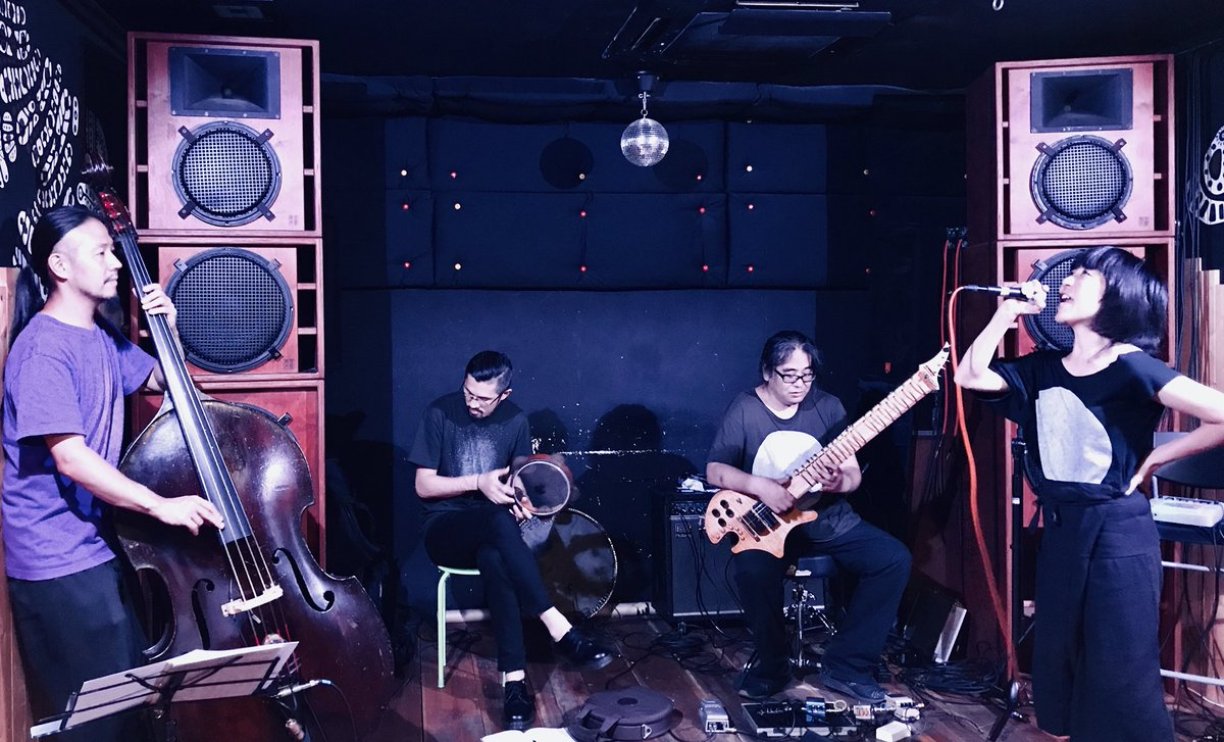Saicobab
Wednesday, May 8th, ISSUE presents the New York City debut of Japanese quartet SAICOBAB, consisting of avant vocalist YoshimiO of Boredoms/OOIOO (celebrated as a battler of Pink Robots by The Flaming Lips) and instrumentalists Yoshida Daikiti (sitar), and Motoyuki “Hama” Hamamoto (percussion, gamelan). The evening also features the ISSUE return of Lizzi Bougatsos & Sadie Laksa’s I.U.D. project, whose spastic and overtly sexual sound embeds an eccentric dub modality into the tension of throbbing industrial music.
SAICOBAB masterfully blend traditional Indian music with melodies and unexpected rhythms using unorthodox instrumentation to create utterly distinct modern ragas. SAICOBAB’s intricate melody and rhythm of the sitar, double bass, voice, and riq (a middleeastern tambourine), reflect the deep connections made musically between traditional Indian and Japanese music and spiritual practices. In classical Indian music, there is a diverse rhythmic system that can be expressed in mathematical equations, and similarly in Japan, there are mathematical concepts such as numerology, yin and yang, and hakuginhi (silver ratio), that have been used in music and performance since ancient times. They note:
“In Indian music, the 9th, 10th, 11th, and 12th beats are considered as “0” and symbolize “the space that is neither fullness or emptiness.” A rhythmic cycle of 4 bars of 4/4 can be counted as triplets. The melody that starts on the 7th beat progresses into a space that is neither fullness or emptiness, and after the 13th, 14th, 15th, and 16th preliminary beats, a new melody emerges from the 1st beat. The melody continues to develop, and after repeating the same phrase 3 times, the melody ends on the 5th beat, and then starts again from the 7th beat. The 1st, 3rd, 5th, and 7th beats that are emphasized in this song have symbolic meaning. 1 is the beginning of everything; the odd numbers signify the sun in yin-yang philosophy; 5 and 7 symbolize the silver ratio; 3, 5, 7 symbolize a protective barrier in ancient Japanese mysticism, and the number “0” symbolizes the void. In Nagarjuna philosophy, the numbers 1, 3, 5, 7 symbolizes the phenomenal world (the temporal world), and the 9th to 16th beats symbolize the quantum space (emptiness), and the listener is in the middle position.”
SAICOBAB is the Japanese quartet of vocalist YoshimiO (Boredoms, OOIOO), Yoshida Daikiti (sitar), Akita Goldman (bass), and acclaimed in Japan Motoyuki “Hama” Hamamoto (percussion, gamelan). On their debut album SAB SE PURANI BAB, YoshimiO’s leaping, animated, effected vocal melodies dance fluidly through Daikiti’s intricate sitar patterns. The entrancing synergy of Goldman and Hama’s rhythmic pulse drives and shapes the aptly named SAICOBAB’s sound to one that is at once rooted in ancient tradition, and wholly new. Since YoshimiO and Daikiti formed SAICOBAB in 2001, the group has expanded beyond their initial improvisations and into an ensemble as formidable in talent as it is in originality. YoshimiO is clearly able to ignore the rules with ease and singular creativity, however she and Daikiti understand that in order to be able to ignore the rules, you need “to train yourself to be aware of the most ancient rules of the universe.” SAICOBAB’s deep understanding of traditions enables them to transform ancient cultural practices into modern playgrounds of creativity.
Videography by Daniel Hewson. Audio recorded by Bob Bellerue. Edited by James Emrick.

